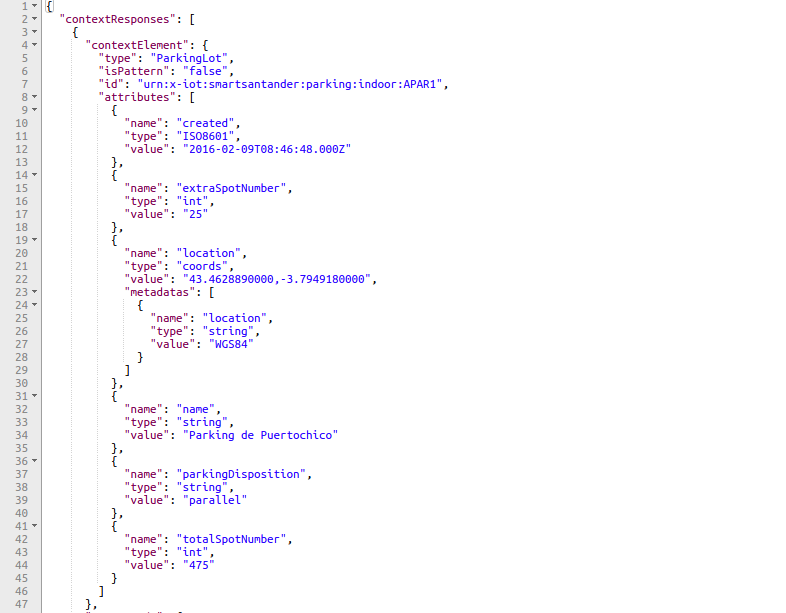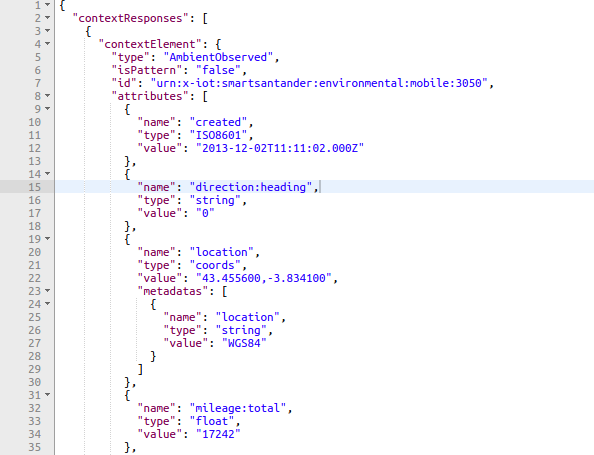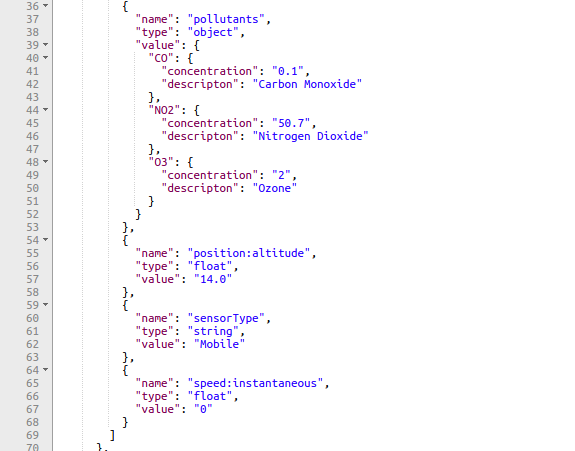FIWARE Platform for Smart Cities
FIWARE is born as the result of a public-private collaboration between the European Commission and the private sector. This open platform, which provides a set of tools for different functionalities, is an innovation ecosystem for the creation of new applications and Internet services. It is especially useful in terms of Smart Cities, as it ensures the interoperability and the creation of standard data models.
In this context, being "Smart" requires first being "Aware", that is, implementing a Smart City requires gathering and managing context information describing the current and historic state of the cities. This context information refers to the values of attributes charterizing relevant entities of city services, governance, and third party apps. In this regard, Smart applications and services for cities do need information about everything happening at every moment, and thus have access to this context information. FIWARE provides a mechanism to generate, collect, publish or query massive context information and use it for applications to react to their context. This is a complex process, as this information may come from different sources: systems, mobile apps’ users, sensor networks, etc. It is our Context Broker, through a REST implementation of API OMA NGSI, which allows to shape and access it, whatever the source is.
The use and management from data coming from “Things” (i.e. sensors, actuators and other devices) is also a complex process, as there are many different protocols in the IoT sphere, but FIWARE provides a set of GEs allowing to access the relevant information through only one API (NGSI). It not only allows to read this sensor information, but also to act on some elements. Therefore, Context Broker is an essential part of the architecture to collect data, analyse them on real time, consult archives and their analysis, as well as to publish them as open data from a city. On the other hand, other functionalities such as business intelligence, web interfaces and advanced interfaces allow the creation of very powerful applications and solutions.
FIWARE IoT Stack
The FIWARE IoT Stack Documentation describes how to connect devices and receive data, integrating all device protocols and connectivity methods, understanding and interpreting relevant information. It isolates data processing and application service layers from the device and network complexity, in terms of access, security and network protocols.
FIWARE « ORION » Context Broker
Orion Context Broker allows you to manage all the whole lifecycle of NGSI context information including updates, queries, registrations and subscriptions. Using the Orion Context Broker, you are able to register context elements and manage them through updates and queries. In addition, you can subscribe to context information so when some condition occurs (e.g. an interval of time has passed or the context elements have changed) you receive a notification.
The Orion Context Broker Documentation describes in detail how to interact with the Context Broker, and thus, how to use the NGSI API for managing context information. On the other hand, this documentation describes how to deploy a dedicated instance of the Orion Context broker.
You can find the source code of Orion in the FIWARE Context Broker Github repository
FIWARE Device Backend Gateway (IDAS)
The FIWARE Device Backend Gateway supports several IoT protocols with a modular architecture where modules are called “IoT Agents”. This compontents allow to simplify the management and integration of devices. It collects data from devices using heterogeneous protocols and translates them into standard platform language: NGSI entities.
The Device Backend Gateway Documentation describes what are the different IoT Agents available and how to develop new agents for non-supported protocols
FIWARE Application Mashup (WireCloud)
WireCloud builds on cutting-edge end-user (software) development, RIA and semantic technologies to offer a next-generation end-user centred web application mashup platform aimed at allowing end users without programming skills to easily create web applications and dashboards/cockpits (e.g. to visualize their data of interest or to control their domotized home or environment). Web application mashups integrate heterogeneous data, application logic, and UI components (widgets) sourced from the Web to create new coherent and value-adding composite applications.
The WireCloud Documentation describes in detail how to interact with the Wirecloud platform, how to develop WireCloud components, and hoy to deploy a dedicated instance.
You can find a running instance in the Mashup portal of the FIWARE Lab
You can find the source code in the WireCloud Github repository
Available Smart City Real Time Data Endpoints
The city of Santander in Spain, relies on FIWARE for publishing its smart city real time data. For this purpose, the city has two different endpoints using NGSI v1 and NGSI v2 respectively.
The NGSI v1 service is deployed on http://mu.tlmat.unican.es:8099/ and queried using the queyContext service. Thise service responses with a contextResponses node containing a list of contextElement, each representing a entitity or sensor. For these entities, it is included the type, the id, and a list of attributes, which is different depending on the type of the entities.
In this endpoint it is published the following information:
- Indoor parkings: Real time information of existing indoor parkings and the number of available spots. In the following screenshot you can find an example of the information returned for an indoor parking:
- As can be seen in the screeshot, ParkingLot entities contain the following attributes:
- created: The creation date in ISO8601 format
- extraSpotNumber: An integuer with the number of available spots for parking
- location: Coordinates of the parking in WGS84 format
- name: Name of the parking
- parkingDisposition: Disposition of the cars in the parking, e.g parallel
- totalSpotNumber: An integuer with the total number of parking spots
- As can be seen in the screeshot, ParkingLot entities contain the following attributes:
- Ambient data: Real time information of ambient data, retrieved from sensors deployed in city buses. The following screenshot shows the information available for these sensors:
- As can be seen in the screenshot, AmbientObserved entities contain the following attributes:
- created: The creation date in ISO8601 format
- direction:heading:
- location: Coordinates of the sensor in WGS84 format
- mileage:total: Total distance covered by the bus where the sensor is deployed
- pollutants: Current values of CO, NO2 and O3
- position:altitude: Current altitude (meters) of the bus where the sensor is deployed
- sensorType: Type of the sensor
- speed:instantaneous: Current speed (km/h) of the bus where the sensor is deployed
- As can be seen in the screenshot, AmbientObserved entities contain the following attributes:
- Ambient Areas: It includes a Geo poligon describing the different ambient areas
- Street Parkings: Including the allowed vehicles (e.g car), the total number of spots, the available spots, and its location
You can find the endpoints and examples on how to query Santander Sensors in the Santander Sensors Postman


